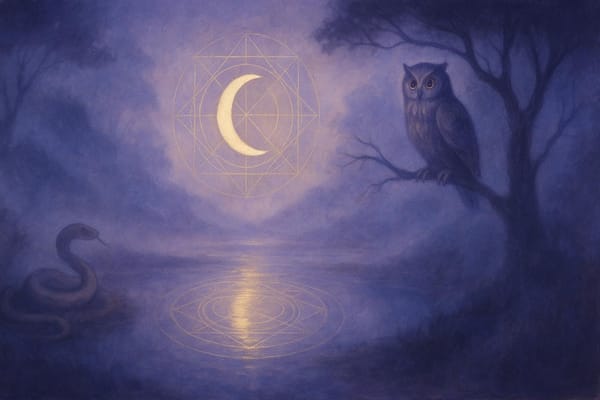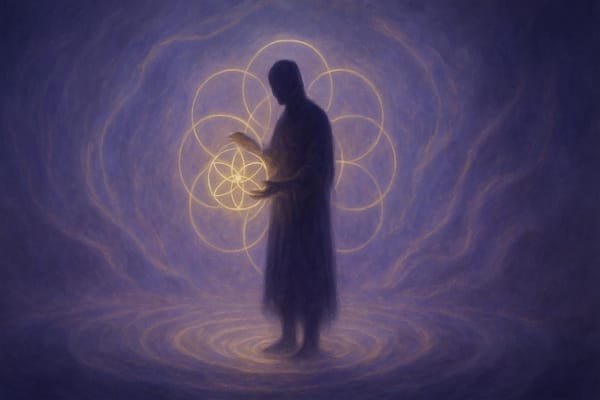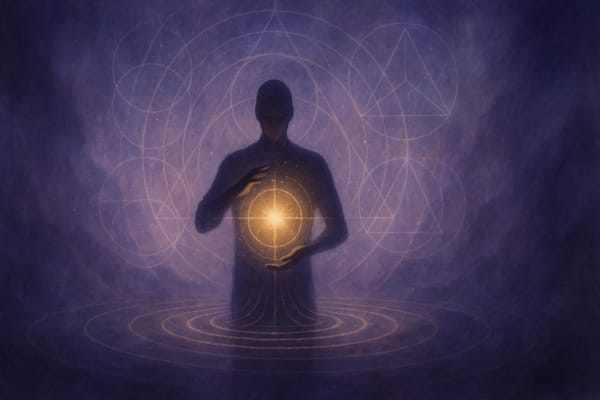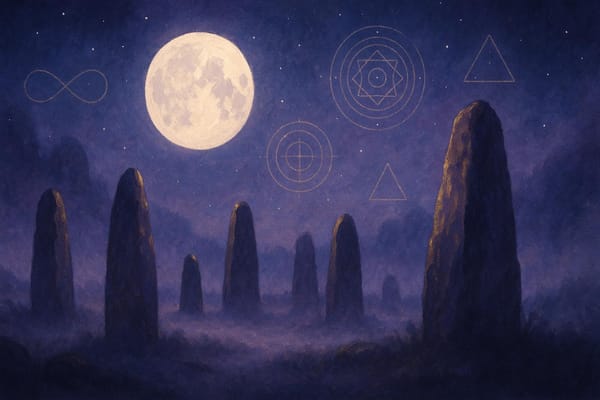Inner Light Practices in Gnostic Thought
Explore Gnostic inner light practices that awaken the divine spark within, revealing deeper truths through visualization, meditation, and breathwork.
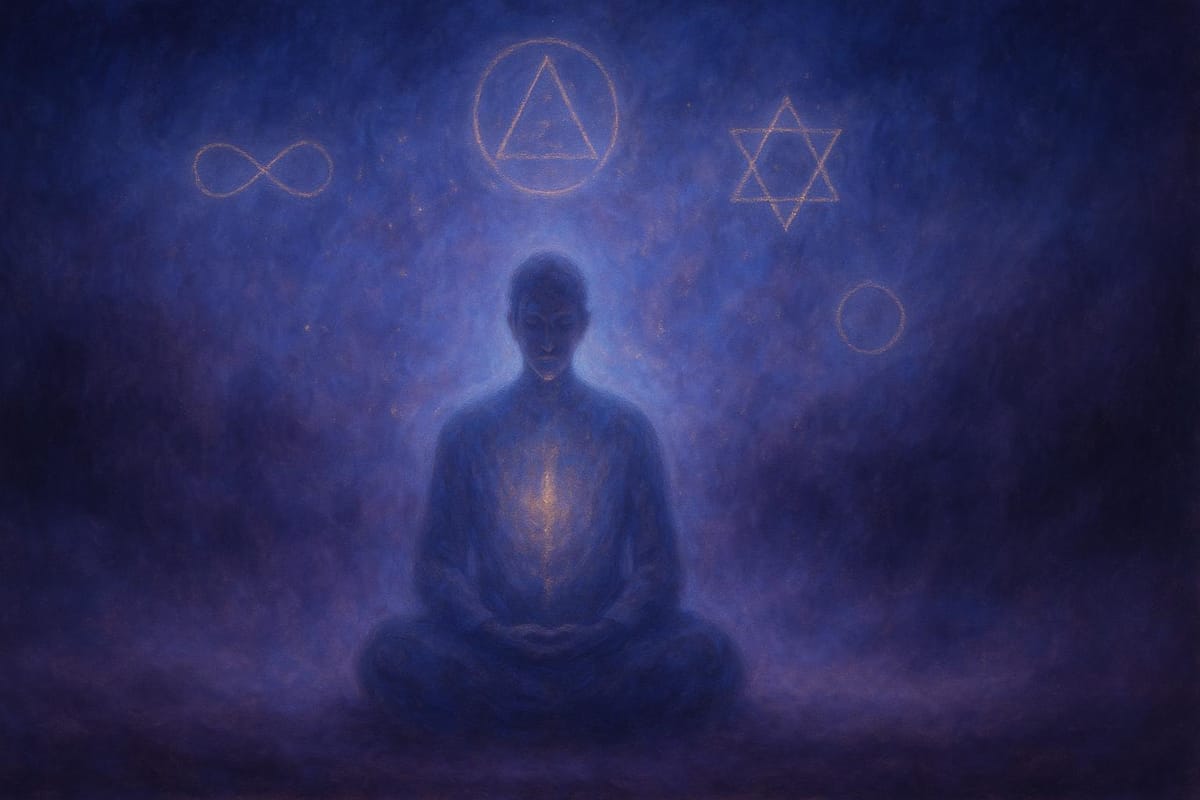
Gnostic traditions teach that a divine light, or "spark", resides within each of us - a fragment of the infinite source, longing to reconnect with its origin. Through visualization, meditation, and breathwork, these practices guide seekers to awaken this inner light, revealing deeper truths hidden beneath the illusions of the material world. The goal is gnosis: a direct, personal experience of the divine that transforms perception and expands awareness.
Key insights include:
- Inner Light: A sacred core within, untouched by the material world, representing our eternal connection to the divine.
- Meditative Practices: Techniques such as light visualization, breathwork, and using sacred sounds help activate this spark.
- Reality as Illusion: Gnostic teachings view the physical world as a veil, urging practitioners to look inward for truth.
- Practical Steps: Daily visualization exercises - like picturing a radiant sun within the chest - bring clarity, emotional balance, and spiritual growth.
These methods are not rigid but deeply personal, offering a way to shift from external distractions to inner illumination. Begin with simple practices like visualizing light flowing through your body and allow the process to unfold naturally.
If something here resonates, you’re not here by accident. Join the journey and explore the divine spark within.
Descent and Ascent | A Gnostic Meditation of Light and Life
Core Principles of Inner Light Visualization
The essence of Gnostic inner light practices rests on three intertwined principles that bring abstract spiritual concepts into a more tangible experience. Together, these principles form a pathway to awaken the divine spark within and move beyond the confines of ordinary perception.
The Divine Spark and Reality as Illusion
Central to Gnostic visualization is the understanding of human nature and the true nature of reality. The divine spark is seen as a fragment of the unknown, ultimate God residing within every individual. Through visualization, practitioners aim to uncover this divine spark, which lies hidden beneath the material world’s surface.
Gnostic teachings regard the material world as an illusion - a veil that conceals the deeper truth. Instead of seeking validation externally or relying on intermediaries, practitioners turn inward to connect with their divine essence. This inward journey reveals the self as a microcosm, a miniature reflection of the entire spiritual universe that mirrors the divine realm. This understanding guides the shift from being trapped in illusion to experiencing inner illumination.
As the illusion of separation begins to fade, practitioners start perceiving a reality that transcends surface appearances. This perspective aligns with current explorations into consciousness and existence, such as those discussed on Sacred Illusion, which delves into concepts like simulation theory and the idea of reality as a system or dream that can be consciously navigated.
Using Imagination in Spiritual Practice
Imagination holds a central role in Gnostic practice, not as mere fantasy but as a tool for spiritual growth and awakening. Disciplined visualization allows practitioners to create inner sanctuaries, undertake symbolic journeys, and bring spiritual concepts into lived experiences. In this way, imagination becomes a bridge between the material and spiritual realms, offering access to states of consciousness that might otherwise remain unexplored.
A key element of this practice is developing the ability to distinguish between mental constructs and images that arise from an awakened state of consciousness - a skill that sharpens with time and dedication. Over time, practitioners learn to recognize spontaneously emerging images that carry a distinct clarity and presence. For instance, a meditator might perceive the elemental essence of a plant or experience lucid dreams that enable exploration of higher realms. These experiences highlight the transformative potential of imaginative practices.
Simple exercises, such as visualizing a candle flame or the sun, can strengthen the imagination and deepen inner vision. These techniques naturally pave the way for practices that bring harmony to the body, mind, and spirit.
Working with Breath, Mantras, and Sacred Words
To deepen the experience of imaginative visualization, physical techniques such as breathwork, mantras, and sacred words are often incorporated. These elements amplify the practice by engaging different layers of the self. Breath serves as a link between the physical and spiritual, helping to move and expand the inner light throughout the body. For example, practitioners may visualize light descending into their body with each inhale, filling them with wisdom and peace as they align with higher energetic states.
Mantras and sacred words further elevate consciousness. The vibrations created by these sounds enhance the visualization process, adding depth and intensity to the practice. When combined with focused imagery, these elements create a powerful synergy, fostering deeper spiritual connection and insight.
A typical session might begin with sitting in a relaxed position, visualizing a divine light above the head as a symbol of higher knowledge. As the practitioner integrates breath and sacred sounds, they maintain focus, allowing transformation to unfold naturally over time.
| Practice Element | Function | Effect |
|---|---|---|
| Breath | Connects the physical and spiritual | Moves energy and amplifies inner light |
| Mantras | Creates vibrational resonance | Elevates consciousness and deepens divine connection |
| Sacred Words | Channels vocal intention | Enhances visualization and supports transformation |
This holistic approach addresses the body, mind, and spirit, creating the ideal conditions for spiritual awakening. Each component works in harmony with the others, supporting the process of discovering and nurturing the divine spark within.
Key Inner Light Visualization Practices in Gnosticism
These practices are designed to help awaken the divine spark within you through focused inner light work.
Light Visualization Meditation
Begin by sitting comfortably and focusing on your breath. Picture a pure, radiant light entering through the crown of your head with each inhale, spreading through every part of your body. As you exhale, imagine releasing tension and shedding layers of spiritual ignorance.
Joel Blackstock LICSW-S MSW PIP explains:
"The divine spark is seen as a kind of inner light or knowledge that, when activated, can lead the individual towards gnosis, or divine understanding"
Through consistent practice, this visualization nurtures the spiritual light within you. Many practitioners report moments of clarity and insight that deepen their connection to this inner luminosity. To enhance this experience, shift your focus to a glowing, heart-centered sun.
Spiritual Sun Visualization
This technique involves visualizing a radiant sun at the center of your chest, a practice deeply rooted in Gnostic teachings. Concentrate on the middle of your chest and imagine a small, golden sun forming there. Gradually, let it grow brighter and larger, its rays extending throughout your body. Picture this light dissolving fear and doubt, replacing darkness with clarity and peace.
Joel Blackstock LICSW-S MSW PIP highlights:
"The concept of the 'divine spark' is a central tenet of Gnostic thought, representing the seed of spiritual light that lies dormant within the human soul"
As this inner sun expands, it aligns you with the divine spark within. For those seeking a deeper connection, the next step is to create an inner sanctuary.
Inner Sanctuary Construction
This advanced practice involves building a sacred inner space through visualization - a personal refuge for spiritual growth and divine communion. Imagine a sanctuary that resonates with you, whether it’s a Greek temple, a Gothic cathedral, or a tranquil meditation hall. Visualize its details vividly: the architecture, the light, the symbols. Explore this sacred space, allowing it to become a stable refuge from the distractions of the material world.
Steve F. elaborates:
"Gnostic Christianity views the divine spark as a portion of God that resides in each of us. By awakening to it, we recognize the divine within and transcend the material world back to its source"
Regular visits to this sanctuary strengthen your inner vision and imagination. Over time, this practice helps you perceive the illusory nature of the external world and supports your ongoing spiritual growth.
The Effects of Inner Light Practices
Inner light practices, rooted in visualization techniques, bring noticeable changes to perception, emotions, and the spirit. By engaging with these methods, individuals can experience shifts that touch the core of their being.
Spiritual Insights and Expanded Awareness
Through consistent practice, inner light techniques unlock pathways to profound, mystical experiences that reshape how reality is perceived. Practitioners often describe moments of gnosis - a deeply personal, experiential understanding that transcends the surface layers of identity.
This expanded awareness dissolves the boundaries of self, revealing a connection to the divine at the heart of existence. These states of heightened clarity not only illuminate spiritual truths but also create opportunities for emotional renewal and growth.
Self-Healing and Emotional Integration
Beyond spiritual insights, inner light work also supports emotional well-being. Visualization activates neural pathways that reduce stress and cultivate emotional balance. With regular practice, individuals often find themselves better equipped to manage anxiety, stress, and other challenging emotions. This heightened self-awareness fosters resilience and helps heal emotional wounds by integrating fragmented parts of the psyche. Over time, recurring emotional patterns can be reframed, leading to healthier coping mechanisms and a stronger sense of inner harmony.
Purification and Enlightenment
These practices also serve as a means of spiritual purification, helping to release fear and doubt while nurturing a sense of peace. As the divine spark within grows brighter, practitioners often develop a direct connection to spiritual truths, moving beyond reliance on external teachings. As Heracleon observed, individuals initially depend on outside sources for spiritual understanding, but with practice, they "discover instead their own immediate relationship with the truth itself". This evolving enlightenment fosters qualities like unconditional love, generosity, and courage, while instilling a deep sense of empowerment that fuels ongoing spiritual growth.
Using Inner Light Practices in Modern Spirituality
Modern spirituality has found a way to weave ancient Gnostic visualization techniques into daily life, emphasizing the importance of consistent practice and lived experience. These timeless methods provide practical tools to navigate the complexities of today’s world while nurturing a deeper connection to the divine essence within.
Daily Applications and Practical Tips
Incorporating inner light practices into your morning routine can set the tone for your entire day. Author and counselor Josie Robinson shared how her life "changed" when she began dedicating even a few minutes each morning to spiritual exercises, emphasizing that just five minutes can make a noticeable difference.
Start your day by visualizing light flowing from the crown of your head, traveling through your chakras, and grounding you to the earth. Imagine this light radiating love from your heart center. Short, consistent sessions - lasting one to five minutes - often prove more impactful than sporadic, longer practices.
You can enrich this practice with complementary techniques. For instance, try chanting mantras like "OM" or holding vowel sounds while visualizing colors associated with each chakra. Morning yoga, such as Sun Salutations performed while facing the rising sun, offers a beautiful way to combine movement, gratitude, and light visualization. Begin each day with the question, "What light can I bring today?" and let the answer arise naturally. As these practices become part of your daily rhythm, you may encounter challenges - something we’ll explore in the next section.
Common Misconceptions and Pitfalls
As you deepen your practice, it's helpful to understand and address common misconceptions. William Black from Bucknell University points out:
"The biggest misconception about visualization is that it will come quickly, naturally, and easily to people. In reality, visualization takes sustained focus, effort, time, and practice."
If your mind wanders during practice, it’s not a failure - it’s simply part of the process. Instead of forcing stillness, gently guide your focus back to the visualization of your inner light. Treat the practice with the ease of recalling a beloved memory, free of rigid expectations about what "should" happen. For moments when your thoughts feel particularly scattered, try imagining the light expanding through your body in just a few seconds.
Another common misunderstanding is viewing visualization as a superficial exercise rather than a transformative experience. Jenna, a Certified Meditation Teacher at Sustainable Bliss, reminds us:
"Too many people shy away from meditating because they think that the goal of meditation is to empty the mind completely and that you've failed if your mind wanders at all."
Approach your practice with patience and curiosity, allowing it to unfold naturally.
Inner Light as a Path to Understanding Reality as Illusion
Inner light practices can also serve as a lens through which we see the constructed nature of our everyday reality. Neuroscientist Patrick Cavanagh explains:
"It's really important to understand we're not seeing reality. We're seeing a story that's being created for us."
This perspective invites us to question conditioned perceptions and explore the narratives shaping our lives. Through regular visualization, you cultivate the ability to observe your thoughts and reactions without immediately identifying with them. This creates space to distinguish between inner truth and external programming, revealing how much of what we perceive is influenced by societal conditioning.
Lee captures this awakening vividly:
"Imagine watching people go about their daily routines, not realizing they're moving through life half-asleep, guided by invisible strings they don't even know exist. Once you've seen it, you can't unsee it."
This shift transforms you from a passive participant in life’s script to an active observer and co-creator. As Pascal Wallisch from New York University notes:
"Your brain makes a lot of unconscious inferences, and it doesn't tell you that it's an inference."
FAQs
What makes Gnostic inner light practices unique compared to other meditation techniques?
Gnostic inner light practices offer a distinctive path, centering on awakening the divine spark within by focusing on the visualization of inner light and sound. These practices are designed to reconnect individuals with their spiritual origins and tap into gnosis - a profound, intuitive understanding of the divine.
Unlike meditation techniques that often emphasize relaxation or mindfulness, Gnostic methods take a more active inward approach. Through visualization, practitioners aim to journey into spiritual realms, seeking a direct encounter with the sacred. It’s not about quieting the mind but about revealing hidden truths and rekindling the memory of one’s connection to the divine essence.
What challenges do beginners face with inner light visualization, and how can they overcome them?
Beginners often find inner light visualization challenging, especially when forming clear mental images feels out of reach. This difficulty might arise from inexperience, conditions like aphantasia, or frustration when progress feels slow. Such feelings can make it harder to stay committed to the practice.
To navigate these hurdles, start with simple steps. Picture a soft, glowing white light or a serene, calming scene. Make it a habit to practice regularly, and try to involve all your senses - imagine the warmth, the texture, or even the sounds associated with your visualization. Most importantly, be patient with yourself. Progress unfolds gradually, and even small, steady steps can lead to meaningful growth. Over time, persistence will deepen your connection to the practice, enriching its impact.
How can I integrate inner light practices into my daily life to enhance spiritual growth?
To bring the practice of connecting with your inner light into your daily routine, begin by carving out a few quiet moments each morning. Use this time for meditation, visualization, or simply reflecting inward. Focus on that divine spark within you through steady, calming breaths or gentle affirmations. Morning offers a unique stillness, making it a perfect moment to align your energy with the rhythm of the day ahead.
Throughout your day, weave in grounding rituals like writing in a gratitude journal, taking a mindful walk in nature, or pausing for moments of stillness. These small but intentional acts help you stay attuned to your inner light, offering steadiness even when life feels uncertain. The key lies in consistency - dedicating just 10–15 minutes each day to these practices can enrich your spiritual connection and nurture a deeper sense of peace and strength.

